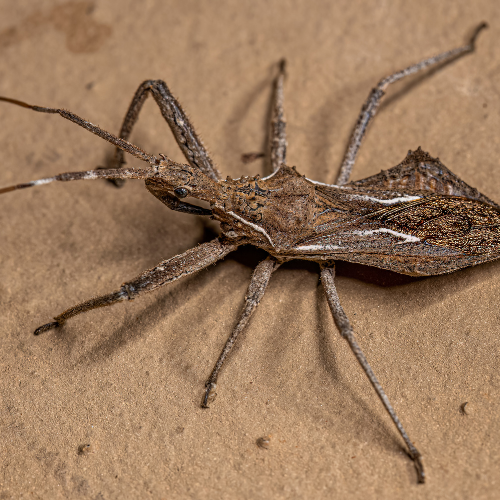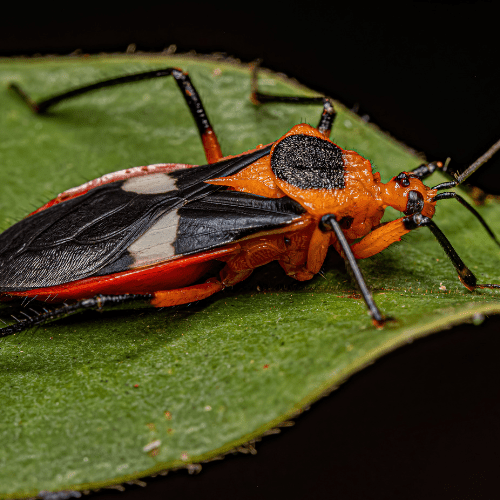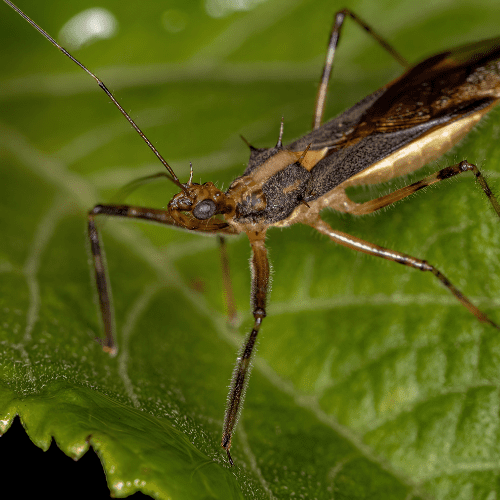Assassin Bug
Introduction to
Assassin bugs are predatory insects known for their hunting prowess and distinctive appearance. While beneficial in controlling pest populations, some species can pose a risk to humans due to their painful bites and potential to transmit diseases. This guide provides detailed information on how to recognize, understand, and manage assassin bugs, including preventive measures and professional pest control solutions.
Recognition
Assassin bugs are generally medium to large-sized insects, measuring between 1/2 to 1 inch in length. They have elongated bodies with narrow heads, long antennae, and a characteristic curved beak used for piercing and sucking. Their colors vary widely among species, ranging from brown and black to bright red or orange. Some species have distinctive patterns or markings. Assassin bugs have long legs that aid in capturing prey and are often found in gardens, forests, and fields. The most well-known species, the wheel bug, has a unique cogwheel-like structure on its thorax.
Biology
Assassin bugs belong to the family Reduviidae and undergo incomplete metamorphosis, developing from eggs to nymphs to adults. Females lay eggs in clusters on plants or in crevices. The nymphs resemble smaller versions of the adults but lack fully developed wings. They molt several times before reaching adulthood. Assassin bugs are generalist predators, feeding on a variety of insects, including caterpillars, beetles, and aphids. They use their sharp beak to inject enzymes into their prey, liquefying the insides, which they then suck out. This feeding behavior makes them beneficial for natural pest control, although some species can also feed on blood, posing a risk to humans and animals.
Habits
Preventing assassin bug encounters involves reducing attractants and securing entry points. Seal cracks and gaps around doors, windows, and foundations to prevent them from entering homes. Use screens on windows and doors and repair any damaged screens promptly. Reduce outdoor lighting at night, as lights can attract insects, including assassin bugs. Keep gardens and yards well-maintained by trimming vegetation and removing debris where these bugs might hide. If you suspect the presence of kissing bugs, take extra precautions to secure sleeping areas and avoid sleeping outdoors or in poorly constructed buildings.
Prevention
When assassin bugs become a persistent problem, professional pest control services can offer effective solutions. STL Pest Control provides comprehensive inspections and tailored treatment plans to address assassin bug infestations. Their methods include sealing entry points, using insecticides when necessary, and providing recommendations to reduce attractants. Professional services ensure that the infestation is managed efficiently and safely, minimizing the risk to humans and pets and reducing the inconvenience caused by these pests.
Professional
When assassin bugs become a persistent problem, professional pest control services can offer effective solutions. STL Pest Control provides comprehensive inspections and tailored treatment plans to address assassin bug infestations. Their methods include sealing entry points, using insecticides when necessary, and providing recommendations to reduce attractants. Professional services ensure that the infestation is managed efficiently and safely, minimizing the risk to humans and pets and reducing the inconvenience caused by these pests.



Our Office









